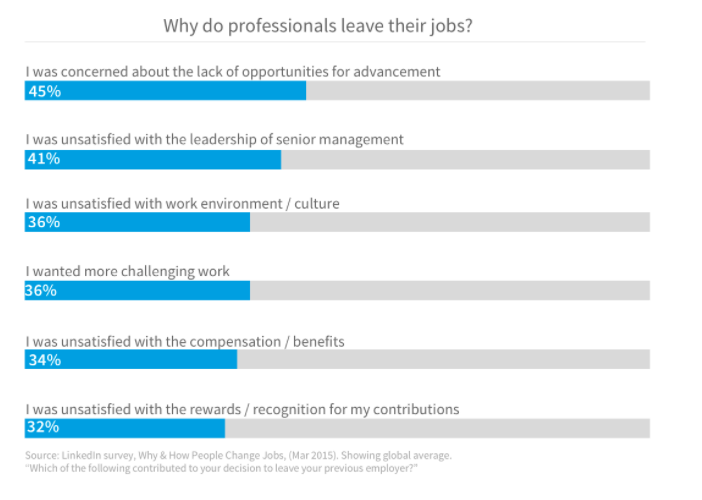Employee Morale: The Hidden Secret to a High NPS
Not sure how to increase your NPS? Check out your employee morale rate for a hint!
“Kids these days don’t understand the meaning of the word loyalty,” my grandfather would say as he boasted about how he worked for the same company doing the same job for over 30 years.
Now, I’m not saying that working for the same company as a gardener for 30 years is a dream, but my grandfather isn’t wrong in what he’s saying: Today’s workforce is quick to jump ship.
In fact, the United States Bureau for Labour Statistics reported that “workers aged 20-24 stay with an organization only 1.1 years on average (compared to 1.5 years just 15 years ago), and workers aged 25-34 stay 2.7 years (compared to over 3 years in the 1980s).”
But for what reason?
Six reasons for employees to leave their job
LinkedIn conducted a survey of 10,000 LinkedIn members to find out the tops reasons why members leave their jobs.
Here are the results:

As you can see, the top reasons people leave their jobs is related to the reality of their work environment. Of course, some external factors, such as geographical area and immigration policy, contribute to turnover, but there is a largely explored connection between employee morale and turnover rate.
Now, I assume that you’ve come across this article in your search to find out how to improve your Net Promoter Score (NPS) or customer satisfaction benchmark.
Read more: “Customer Service Skills: What You Need to Master”
How do employee morale and NPS relate to one another?
The heads of customer support revealed in our interviews that their higher-level managers look at customer support as a cost rather than an asset. This is because employees often only spend one and a half to two years at these companies even though the onboarding process takes a total of one and a half to three months to complete, and this is a costly cycle.
According to a study conducted by Deloitte, “it takes about $12k to replace the average non-professional or frontline person.”
Because customer support is considered a cost, the heads of customer support have very little resources to handle the workload of hiring and training new employees consistently.
And guess what, the employees can see and feel the lack of resources because the right tools are not in place to create a pleasant work environment.
Referring to the graph above, 36% of LinkedIn members left their job because they were dissatisfied with their work environment. If you’re dissatisfied with your work environment, naturally your performance suffers, and eventually, you feel so dissatisfied that you want to leave.
And the reason my grandfather stayed in with the same company for 30 years is not the same reason that my 24-year old sister would stay at a company for 30 years - my grandfather viewed work as a means of providing for his family while my sister currently views work as a means of happiness. If her work environment is not making her happy, then she won’t be placing her best foot forward on the job, and will likely want to quit.
“The customer seeks support when something has occurred; it is a critical stage in the customer relation. The contact is the point when the uniqueness of the service is experienced. Or missed.” – Omnicus
Therefore, in order to increase the number of positive contact points between the customer and your employee, try improving your employee morale.
Read more: Five other ways to enhance the customer experience.
How To Improve and Measure Employee Morale

Here are a few examples of how you can improve employee morale to boost your NPS:
- Make Employee Morale a Conversation: Very few managers take the time to speak with their employees really. I suggest announcing that every Tuesday (for example) you will take 15 minutes (or so) at the end of the workday to bring up issues/ where their’s room for improvement. Announcing your employee morale meeting ahead of time will give employees time to think about their needs. Furthermore, having it once a week will help you to keep up with their problems as well as give peace of mind to your employees that they have time to speak about their needs.
- Respond To The Feedback Promptly: Once you’ve received the feedback from your employees, make the appropriate changes as soon as possible. This way, people will be able to see the change.
- Research The Right Tools For Your Needs: You can integrate different tools to not only track the efforts of your team but to also make their lives easier. For example, Omnicus takes some of the pressure of call center employees by sensing when an external event has occurred and notifying customers automatically. This way, fewer customers have to call in to find out what’s happened and your employees are free to deal with more pressing matters.
- Don’t Forget About NPS!: Lastly, measure your NPS on a monthly basis to see if you can find a correlation between your employee morale efforts and NPS. I think you’ll be pleasantly surprised! Conclusion
Remember, each company is different, and each team of employees will respond differently to your efforts. Improving employee morale is a trial and error process that takes time to change.
The idea is to implement the right tools, ask for feedback, and, most importantly, stay positive! The effect will rub off, trust me!
Read more: How to integrate and offer customer support day or night
Source:
- http://www.qatc.org/winter-2015-connection/exploring-call-center-turnover-numbers/
- https://static1.squarespace.com/static/57a34fcde6f2e10d061bc16b/t/57b5d0d1d482e9340441457a/1471533267181/How+to+Increase+Contact+Center+Agent+Retention_nGUVU.pdf
- https://gazelles.com/static/resources/articles/aBetterWayMeasuerEmployeeHappiness.pdf
- https://blog.bonus.ly/how-to-boost-employee-morale-and-experience-its-many-benefits
